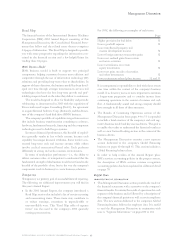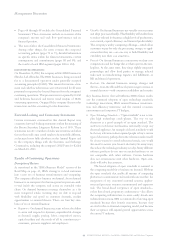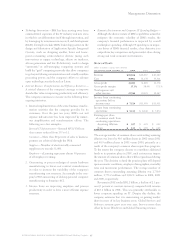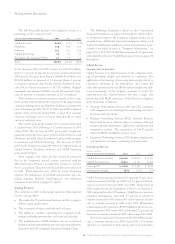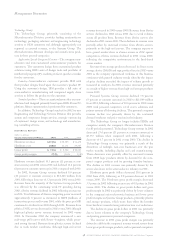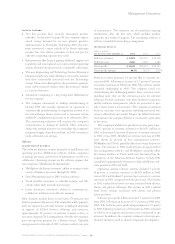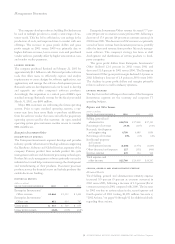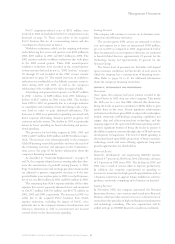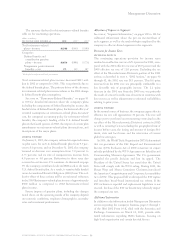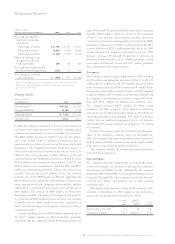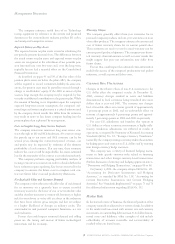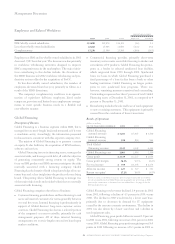IBM 2002 Annual Report Download - page 53
Download and view the complete annual report
Please find page 53 of the 2002 IBM annual report below. You can navigate through the pages in the report by either clicking on the pages listed below, or by using the keyword search tool below to find specific information within the annual report.
Management Discussion
51international business machines corporation and Subsidiary Companies
PwCC acquisition-related costs of $292 million were
incurred in 2002 and included the PwCC compensation costs
discussed on page 78. These costs relate to the acquired
PwCC business that are of a nonrecurring nature and also
contributed to the increase in SG&A.
Workforce reductions, which are the ongoing reductions
and rebalancing that occur each quarter, were $300 million in
2002, $285 million in 2001 and $167 million in 2000. The
2002 amount excludes workforce reductions that took place
in the 2002 second quarter. These 2002 second-quarter
workforce reductions were recorded in the second-quarter
actions amount disclosed in note s, “2002 Actions,” on pages
90 through 92 and included in the 2002 actions amount
mentioned on page 50. The annual increases in workforce
reductions are attributable to the difficult economic environ-
ment during 2001 and 2002, as well as the company’s
rebalancing of the workforce for shifts in required skills.
Advertising and promotional expense was $1,427 million
in 2002, a decline of $188 million from 2001 following a
decline of $127 million in 2001 versus 2000. The declines
from 2000 to 2002 are primarily due to a strategic initiative
to consolidate and centralize certain advertising at the corpo-
rate level in order to gain additional efficiencies. The
decreases in 2002 were primarily in spending associated with
direct response advertising, business partner programs and
customer and sales events. The decline in 2001 was primarily
driven by lower spending on brand advertising and promo-
tional spending.
The provision for bad debts expense in 2002, 2001 and
2000 was $673 million, $490 million and $270 million, respec-
tively. The increases were related primarily to the company’s
Global Financing receivables portfolio and were the result of
the weakening economy and exposures in the Communica-
tions sector. See page 62 for further information about the
company’s financing receivables.
As described in “Standards Implemented,” on pages 75
and 76, the company adopted new accounting rules that elim-
inate the amortization of goodwill starting January 1, 2002.
Page 76 includes income and earnings per share amounts that
are adjusted to present comparative amounts as if the new
goodwill rules were in place prior to 2002. Goodwill expense,
net of tax, was $262 million in 2001 and $436 million in 2000.
The remaining base SG&A expense includes all the other
expenses that are not separately discussed above and amounted
to $14,557 million, $14,396 million and $14,778 million in
2002, 2001 and 2000, respectively. The increase in 2002 was
solely due to the acquired PwCC business. Base SG&A
expense reductions, excluding the impact of PwCC, were
primarily due to the company’s business transformation and
efficiency initiatives as well as concentrated and focused
control of day-to-day discretionary spending.
Looking Forward
The company will continue to execute on its business trans-
formation and efficiency initiatives.
The second quarter 2002 actions are estimated to reduce
cost and expense by at least an incremental $900 million,
pre-tax, in 2003 as compared to 2002. Approximately half of
these incremental cost and expense reductions are estimated
to benefit Global Services, approximately 25 percent for the
Te chnology Group and approximately 20 percent for the
Systems Group.
The future level of provision for bad debts will depend
upon economic conditions and the health of each sector in
which the company has a concentration of financing receiv-
ables. Refer to pages 61 to 63 for additional information
about the company’s financing receivables.
research, development and engineering
Description
Once again, the company had more patents awarded in the
United States in 2002 than any other company. This marks
the 10th year in a row that IBM achieved this distinction.
Being the leader in patents contributes to IBM’s ability to gain
market share in key areas. Recent significant achievements
and initiatives that have given IBM an edge in the marketplace
include autonomic (self-healing) computing capabilities and
copper chip and silicon-on-insulator technology, and the
ongoing support of the open standard Linux operating system.
Another significant benefit of being the leader in patents is
the ability to generate income through sales of IP and custom
development arrangements. The level of R&D spending is
determined based upon IBM’s projections of future customer
technology needs and areas offering significant long-term
growth opportunities for shareholders.
Historical Results
Research, development and engineering (RD&E) expense
declined 4.7 percent in 2002 from 2001, following a decrease
of 1.9 percent in 2001 from 2000. The declines in 2002 and
2001 were a result of actions taken to improve productivity.
In addition, the company reprioritized its spending to
increase its investment in high-growth opportunities such as
e-business, initiatives to support Linux, middleware software
products, autonomic computing and e-business on demand.
Looking Forward
In November 2002, the company announced On Demand
Innovation Services, a new services arm located in its Research
Division, which provides customers access to a discrete team of
researchers who specialize in high-end business transformation
and technology consulting. The new organization will be
staffed with up to 200 IBM Research consultants worldwide.




